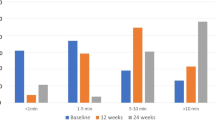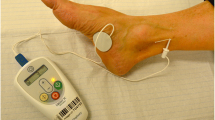Abstract
Background
The effect of posterior tibial nerve stimulation (PTNS) on the mechanisms of anal continence has not been fully demonstrated. The aim of this study was to assess the anal manometric response after percutaneous PTNS in patients with fecal incontinence (FI).
Methods
This was a prospective study in patients with FI undergoing 1 weekly session of percutaneous PTNS for 8 weeks. A clinical assessment (Wexner scale) and a complete study of up to 22 manometric parameters were carried out prior to treatment and 2–4 weeks after the end of treatment.
Results
A total of 32 patients were evaluated. After therapy, there was a decrease in the average Wexner score [12.6 (± 5.2) to 9.5 (± 5.2) (P < 0.005)] and an increase in the “anal canal length at rest” [4.55 (± 0.60) to 4.95 (± 0.21) P = 0.004], without observing variations in other manometric parameters. The decrease in the Wexner score was significantly correlated with an increase in the “pressure at 5 cm at rest” after therapy (r = 0.464 P = 0.030).
Conclusions
In our study, PTNS was associated with a significant decrease in the Wexner score and with an increase in the functional length of the anal canal at rest. The improvement in the Wexner scale was correlated with an increase in pressure at rest in the theoretical area of the anorectal junction.
Similar content being viewed by others
References
Macmillan A, Merrie AEH (2007) Epidemiology of Faecal Incontinence. In: Ratto C, Doglietto GB (eds) Fecal incontinence. Diagnosis and treatment. Springer-Verlag, Milan
Hotouras A, Murphy J, Allison M, Curry A, Williams NS, Knowles CH, Chan CL (2014) Prospective clinical audit of two neuromodulatory treatments for fecal incontinence: sacral nerve stimulation (SNS) and percutaneous tibial nerve stimulation (PTNS). Surg Today 44(11):2124–2130
Horrocks EJ, Thin N, Thaha MA, Taylor SJ, Norton C, Knowles CH (2014) Systematic review of tibial nerve stimulation to treat faecal incontinence. Br J Surg 101(5):457–468
Leroi AM, Siproudhis L, Etienney I, Damon H, Zerbib F, Amarenco G, Vitton V, Faucheron JL, Thomas C, Mion F, Roumeguère P, Gourcerol G, Bouvier M, Lallouche K, Menard JF, Queralto M (2012) Transcutaneous electrical tibial nerve stimulation in the treatment of fecal incontinence: a randomized trial (CONSORT 1a). Am J Gastroenterol 107(12):1888–1896
Knowles CH, Horrocks EJ, Bremner SA, Stevens N, Norton C, O’Connell PR, Eldridge S, CONFIDeNT study group (2015) s.1. Percutaneous tibial nerve stimulation versus sham electrical stimulation for the treatment of faecal incontinence in adults (CONFIDeNT): a double-blind, multicentre, pragmatic, parallel-group, randomised controlled trial. Lancet. 386(10004):1640–1648
Jorge JM, Wexner SD (1993) Etiology and management of fecal incontinence. Dis Colon Rectum 36(1):77–97
Rockwood TH, Church JM, Fleshman JW et al (2000) Fecal incontinence quality of life scale. Dis Colon Rectum 43:9–17
De la Portilla F, Rada R, Vega J, Gonzalez CA, Cisneros N, Maldonado VH (2009) Evaluation of the use of posterior tibial nerve stimulation for the treatment of fecal incontinence: preliminary results of a prospective study. Dis Colon Rectum 52:1427–1433
De la Portilla F, Laporte M, Maestre MV, Díaz-Pavón JM, Gollonet JL, Palacios C, Vázquez-Monchul JM, García-Cabrera AM, Jiménez-Rodríguez RM, Sánchez Gil JM (2014) Percutaneous neuromodulation of the posterior tibial nerve for the treatment of faecal incontinence—mid-term results: is retreatment required? Colorectal Dis 16(4):304–310
George AT, Kalmar K, Sala S, Kopanakis K, Panarese A, Dudding TC, Hollingshead JR, Nicholls RJ, Vaizey CJ (2013) Randomized controlled trial of percutaneous versus transcutaneous posterior tibial nerve stimulation in faecal incontinence. Br J Surg 100(3):330–338
Arroyo A, Parra P, Lopez A, Peña E, Ruiz-Tovar J, Benavides J, Moya P, Muñoz J, Alcaide MJ, Escamilla C, Calpena R (2014) Percutaneous posterior tibial nerve stimulation (PPTNS) in faecal incontinence associated with an anal sphincter lesion: results of a prospective study. Int J Surg. 12(2):146–149
Queralto M, Portier G, Cabarrot PH, Bonnaud G, Chotard JP, Nadrigny M, Lazorthes F (2006) Preliminary results of peripheral transcutaneous neuromodulation in the treatment of idiopathic fecal incontinence. Int J Colorectal Dis. 21(7):670–672
López-Delgado A, Arroyo A, Ruiz-Tovar J, Alcaide MJ, Diez M, Moya P, Santos J, Calpena R (2014) Effect on anal pressure of percutaneous posterior tibial nerve stimulation for faecal incontinence. Colorectal Dis 16(7):533–537
Marti L, Galata C, Beutner U, Hetzer F, Pipitone N, Wolff K, Borovicka J, Brunner W, Sulz MC, Maurus C (2017) Percutaneous tibial nerve stimulation (pTNS): success rate and the role of rectal capacity. Int J Colorectal Dis. 32(6):789–796
Shafi KA, Ahmed I, El-Sibai O (2003) Mostafa RM (2003) Percutaneous peripheral neuromodulation in the treatment of fecal incontinence. Eur Surg Res. 35(2):103–107
Mentes B, Yuksel O, Aydin A, Tezcaner T, Leventoglu A, Aytac B (2007) Posterior tibial nerve stimulation for faecal incontinence after partial spinal injury: preliminary report. Tech Coloproc 11:115–119
Govaert B, Pares D, Delgado-Aros S, La Torre F, Van Gemert WG, Baeten CG (2010) A prospective multicentre study to investigate percutaneous tibial nerve stimulation for the treatment of faecal incontinence. Colorectal Dis. 12(12):1236–1241
Peña Ros E, Parra Baños PA, Benavides Buleje JA, Muñoz Camarena JM, Escamilla Segade C, Candel Arenas MF, Gonzalez Valverde FM, Albarracín Marín-Blázquez A (2016) Short-term outcome of percutaneous posterior tibial nerve stimulation (PTNS) for the treatment of faecal incontinence. Tech Coloproctol 20(1):19–24
Boyle DJ, Prosser K, Allison ME, Williams NS, Chan CL (2010) Percutaneous tibial nerve stimulation for the treatment of urge faecal incontinence. Dis Colon Rectum 53(4):432–437
Hotouras A, Thaha MA, Allison ME, Currie A, Scott SM, Chan CL (2012) Percutaneous tibial nerve stimulation (PTNS) in females with faecal incontinence: the impact of sphincter morphology and rectal sensation on the clinical outcome. Int J Colorectal Dis. 27:927–930
Hotouras A, Thaha MA, Boyle DJ, Allison ME, Currie A, Knowles CH, Chan CL (2012) Short-term outcome following percutaneous tibial nerve stimulation for faecal incontinence: a single-centre prospective study. Colorectal Dis. 14(9):1101–1105
Hotouras A, Murphy J, Walsh U, Allison M, Curry A, Williams NS, Knowles CH, Chan CL (2014) Outcome of percutaneous tibial nerve stimulation (PTNS) for fecal incontinence a prospective cohort study. Ann Surg. 259(5):939–943
Van der Wilt AA, Giuliani G, Kubis C, van Wunnik BPW, Ferreira I, Breukink SO, Lehur PA, Torre L, Baeten CGMI (2017) Randomized clinical trial of percutaneous tibial nerve stimulation versus sham electrical stimulation in patients with faecal incontinence. Br J Surg. 104(9):1167–1176
Bouguen G, Ropert A, Lainé F, Pequin P, Morcet J, Bretagne JF, Siproudhis L (2014) Effects of transcutaneous tibial nerve stimulation on anorectal physiology in fecal incontinence: a double-blind placebo-controlled cross-over evaluation. Neurogastroenterol Motil 26(2):247–254
Vigorita V, Rausei S, Pereira TP, Trostchansky I, Ruano Poblador A, Moncada Iribarren E, Facal Alvarez C, de San Pereira IA, Casal Núñez E (2017) A pilot study assessing the efficacy of posterior tibial nerve stimulation in the treatment of low anterior resection syndrome. Tech Coloproc 21(4):287–293
Author information
Authors and Affiliations
Corresponding author
Ethics declarations
Conflict of interest
The authors declare that they have no conflict of interest.
Ethical approval
The study was approved by the Clinical Research Ethics Committee of the Hospital of Sagunto.
Informed consent
Informed consent was obtained from all participants included in the study
Additional information
Publisher's Note
Springer Nature remains neutral with regard to jurisdictional claims in published maps and institutional affiliations.
Rights and permissions
About this article
Cite this article
Rodríguez Carrillo, R., Ruiz Carmona, M.D., Alós Company, R. et al. Evaluation of the anorectal motor response after percutaneous stimulation of the posterior tibial nerve in patients with fecal incontinence. Tech Coloproctol 23, 987–992 (2019). https://doi.org/10.1007/s10151-019-02092-w
Received:
Accepted:
Published:
Issue Date:
DOI: https://doi.org/10.1007/s10151-019-02092-w




